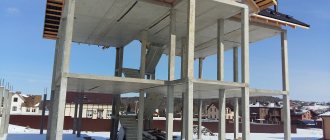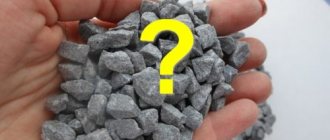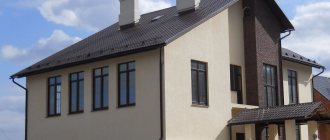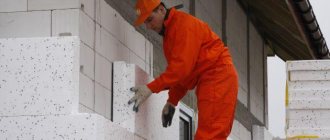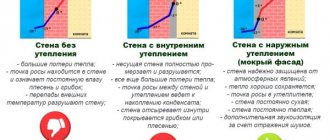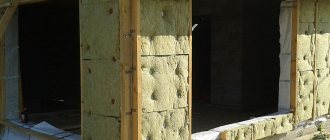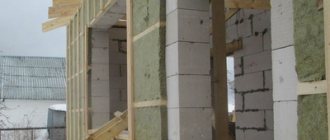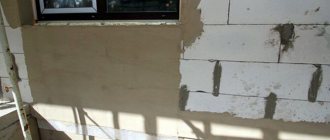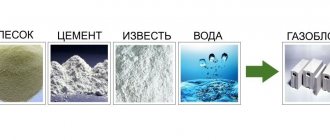Aerated concrete (gas silicate) is one of the most popular materials in modern house construction. Houses made of aerated concrete have become a familiar part of the countryside landscape; from 15 to 20% of new buildings built over the past 10 years are houses made of aerated concrete blocks. The porous structure of the material, characteristic of all lightweight concrete, ensures high performance characteristics of the structure. In many cases, owners decide to carry out additional insulation of the house using aerated concrete from the outside. This measure allows you to minimize heat loss and improve the microclimate of your home.
A house made of aerated concrete needs high-quality insulation Source makemone.ru
About the need for insulation
The structure of aerated concrete is a complex system of many open cells (voids) filled with air. This structural feature determines two useful properties of the material:
- Good thermal insulation . The manufacturer claims that the porous structure of aerated concrete brings its thermal insulation properties closer to wood, and is three to four times superior to brick. In the middle zone, according to SNiPs, the thickness of external walls of 400-500 mm will be sufficient without additional insulation if a block of a grade no lower than D500 is used. These calculations are correct, but do not take into account the second property of aerated concrete.
- Gas permeability . Open pores mean that the material is able not only to transmit, but also to accumulate moisture, which is what happens during the operation of the house. Walls that have absorbed a certain amount of moisture become denser (water accumulates in the pores, like in capillaries). The thermal conductivity of such walls increases, and the ability to retain heat decreases, which is especially noticeable in regions with harsh winters. And if in the south (where the winter temperature difference between inside and outside the building is small) country houses do not need insulation, then to the north the walls must be protected.
The properties of aerated concrete are determined by its structure Source pinterest.com
Features of aerated concrete
Aerated concrete is a building material from the cellular concrete family. It was developed for specific tasks - reducing the weight of buildings and reducing heat loss due to the high thermal conductivity of the walls. The problems were solved by reducing the density due to the formation of a large number of air bubbles in the array.
The composition of aerated concrete includes:
- Portland cement;
- quartz sand;
- lime;
- aluminum powder;
- water.
Sometimes gypsum or other additives are added to the composition to provide increased strength or elasticity.
The material production technology consists of several stages:
- combining components in a certain percentage;
- placing the material in molds and allowing the mixture to mature;
- cutting into blocks and placing in an autoclave for heat treatment;
- removing finished blocks from the autoclave and sending them to trading organizations.
The component that gives the material a porous structure is aluminum powder. It combines with lime and water and causes gas evolution; small (2-4 mm) bubbles appear in the solution mass. Thanks to them, aerated concrete receives its specific qualities - low weight and low thermal conductivity. This allows you to build residential buildings up to 3 floors high and significantly save on heating costs, and make a foundation with a reduced load-bearing capacity.
Principles for choosing insulation
When choosing a suitable material for insulating aerated concrete walls, three factors are taken into account:
- Physical properties of the material . Aerated concrete can regulate the humidity in the room: the walls breathe, allowing water vapor to pass out. The external cladding should not impede this diffusion.
- Properties of insulation . It should not just be vapor permeable; vapor permeability should be higher than that of aerated concrete blocks.
- Insulation rule . It says: the vapor permeability of each subsequent layer of facade insulation should increase. If the selected material cannot easily allow air to pass out, then a ventilated gap must be installed behind it.
Compliance with these conditions helps to shift the dew point beyond the walls. If the masonry is not protected by anything, the moisture accumulating inside will inevitably freeze in severe frost. This leads to noticeable heat loss; after several cycles of freezing and thawing, the destruction of the surface layer of the blocks may begin.
Good to know! The dew point is a plane in the thickness of the wall where, due to the difference in external and internal temperatures, water vapor condenses into dew. With proper organization of external insulation, the dew point moves outward and cannot harm the walls.
Dew point shift when using insulation Source 1bcm.ru
The energy efficiency of a house is affected not only by correctly selected insulation, but also by the quality of wall masonry. If the interblock seams are made incorrectly (too thick), even high-quality insulation will not give the desired effect. Glue joints with a thickness of 1.5-2 mm are considered optimal. Laying blocks on cement-sand mortar with a seam of 10-12 mm will increase heat loss (and heating bills) by 20-20%.
Types and advantages of facade insulation
There is an alternative possibility - insulating the building from the inside. This option is less preferable for several reasons:
- Living space will decrease.
- effective ventilation system will need to be installed .
- There will be a high risk of mold formation , as the dew point will shift inside the home. Moisture and heat are optimal conditions for unpretentious microorganisms and fungi.
Video description
About mistakes when insulating aerated concrete in the following video:
Internal insulation reduces the usable area of housing Source makemone.ru
Considering different options for how to insulate a house made of aerated concrete from the outside, many opt for ordinary or mineral plaster; the latter is specifically designed for aerated concrete walls. The insulation layer can be sheathed with several finishing materials:
- Siding or clapboard .
- Face brick or decorative stone .
- Plaster.
- Grouting the joints followed by the use of vapor-permeable facade paint .
Installation of an insulating layer on the outside has the following positive aspects:
- The energy efficiency of the building increases and heating bills decrease.
- Load-bearing walls are not exposed to natural forces, which increases the service life of a country house.
- Along with improved sound insulation of walls, living comfort increases .
- The appearance of facade walls improves .
Scheme of a ventilated facade with finishing Source gettarget.ru
See also: Catalog of companies that specialize in insulating country houses.
Is it necessary to insulate houses made of aerated concrete?
Discussion of the need to insulate an aerated concrete or gas silicate house continues from the moment the material appears. Some experts believe that insulating aerated concrete from the outside or inside is an unnecessary and useless procedure, since the material’s own qualities are designed to save heat. Other experts argue that insulating aerated concrete houses is a necessity. They confirm their point of view with very compelling arguments - the results of practical observations and calculations based on analysis of the material.
It is impossible to develop a common point of view, since experts look at houses in different conditions. However, many years of practice have shown that supporters of the procedure have much more grounds than opponents. In the harsh Russian climate, it is necessary to insulate aerated concrete walls, otherwise they cannot cope with the resulting loads and cannot provide a sufficiently comfortable temperature in the house.
Video description
We will dwell in more detail on insulating a house with polystyrene foam. Find out how safe polystyrene foam is in our video:
Foam insulation Source beton-house.com
- Installation of foam plastic . It is placed in the spaces between the frame elements, additionally secured with foam or glue.
- Fixing the slabs . The foam sheathing is additionally reinforced with plastic dowels (metal dowels are not suitable, as they create cold bridges).
- Decorative finishing . A primer is applied to the foam layer, a fiberglass mesh is fixed on top, then reinforcing glue is applied. After the glue has dried, finishing is done with decorative or warm plaster.
See also: Catalog of projects of houses made of aerated concrete blocks presented at the exhibition “Low-Rise Country”.
How to insulate with penoplex itself?
Everything is done in several stages:
- Level the façade walls, seal cracks, and treat with primer.
- Glue the penoplex with glue and then fasten it with dowels.
- Apply reinforced mesh for finishing.
- “Finish” the finishing with façade plaster.
If you make the facade with siding or PVC panels, then do not forget to install vertical guides. Additionally, there is no need to cover anything with a vapor barrier, since the material will already be protected by vinyl siding.
The advantage of penoplex insulation is that you can install it yourself, even with two hands.
Insulation with mineral wool
Mineral wool is presented on the market in the form of slabs and rolls. It is actively used for insulating facade walls; basalt slabs are a special case of mineral wool, with similar qualities and performance characteristics. The widespread use of mineral wool is due to its many positive qualities:
- Good vapor permeable properties .
- High strength and immunity to biohazards. Materials are available in different hardness categories.
- Fire resistance (in case of fire it does not burn, but melts).
- Environmental friendliness . The basis of mineral wool is natural components that are not hazardous to human health.
Insulation with mineral wool Source no.decorexpro.com
Installation of mineral wool on the facade is carried out in the following order.
- Facade preparation . The wall is cleaned and leveled using cement mortar. Then the surface is primed and, if necessary, additionally leveled with vapor-permeable plaster.
- Frame installation . The guides of the frame structure are fixed taking into account the size of the material used (roll or rectangular mats). Thanks to the frame, a ventilation gap is formed, sufficient for air circulation along the wall and steam removal.
- Fastening mineral wool . It is carried out using glue applied to the slab material. Additional fixation is provided by plastic umbrella dowels.
- Preparing for finishing . The mineral wool layer is reinforced with mesh and glue.
- Finishing . The walls are coated with primer and plastered; The second common option is to cover it with putty and paint it. When finishing, do not use acrylic plaster, which has moisture-proof properties; such a coating will cause condensation to form.
Step-by-step instructions for thermal insulation of walls with mineral wool
Mineral wool is a material with a cellular structure that has high thermal insulation characteristics. Mineral wool, which is produced in rolls, tends to sag over time, while products produced in the form of mats are considered more durable.
The mats are able to maintain their dimensions and heat-saving properties throughout the entire period of operation. For this reason, the facades and walls of buildings are most often insulated with this particular heat-insulating material.
Sequence of work:
- If moisture gets on them during the laying of walls made of gas silicate blocks, then before starting work on thermal insulation, they need to be given time (at least 1-3 months) to dry thoroughly. If you “lock in” the moisture that has entered the thickness of the material, this will contribute to the freezing of the walls and the destruction of the blocks.
- Next, you need to carefully inspect all the external seams. The mortar seams need to be resealed. Polyurethane foam is best suited for this purpose.
- Polyurethane foam must also be used to fill all cracks and voids on the surface of the cellular concrete.
- To maintain good adhesive properties of the adhesive composition, the surface of the blocks must be sanded with sandpaper.
Insulation under facing bricks
Fastening with dowels
Do not forget to check the availability of communication channels before starting work.
IMPORTANT!
The method of insulating walls made of aerated concrete with mineral wool can be carried out using special adhesive compositions, and you can also use the method of dry thermal insulation.
We will look at the second method in detail:
- You need to attach brackets to the wall, on which the guides will subsequently be installed.
- Next, using plastic dowels, you need to mount mineral wool slabs. The slabs should be installed sideways; the formation of cracks and voids between the sheets of material should be avoided, as this can lead to the formation of “cold bridges”.
- A windproof, vapor-permeable film must be laid on top of the heat-insulating layer. The film is laid overlapping in increments of 10-15 cm, the seams are sealed with mounting tape.
- To ensure ventilation, it is necessary to provide an air gap between the heat-insulating material and the cladding by installing a counter-lattice.
- The final stage is covering the walls with siding.
Thermal insulation with penoplex
Expanded polystyrene
Extruded polystyrene foam (EPS) is one of the types of foam plastic. Expanded polystyrene is produced by foaming the starting ingredients at high temperature and pressure. The production method determines the physical properties of the material - it is mechanically strong, frost-resistant and can have different densities. The higher the density (and strength) of EPS, the higher the thermal conductivity. Vapor and air permeability are always at the same (low) level, and water absorption is minimal. The combination of qualities makes it possible to widely use EPS as an insulating facade material.
An undesirable property of polystyrene foam for aerated concrete walls - low vapor permeability, leading to the appearance of a thermos effect and a shift in the dew point - is avoided by installing a ventilation gap. As in the case of using polystyrene foam, the second option is possible - installing powerful supply and exhaust ventilation. Installation of the insulating layer and decorative finishing is carried out according to the same scheme as for foam plastic.
Expanded polystyrene boards Source ko.decorexpro.com
Polyurethane foam (PPU)
The material refers to sprayed substances; its application requires special equipment, which makes it not the most popular choice in private housing construction. After spraying, a homogeneous sealed layer with the following properties is formed on the wall:
- PPU penetrates the porous surface layer of the aerated concrete facade and forms a strong bond with it that does not collapse over time.
- The thermal conductivity of polyurethane foam, depending on density, is intermediate between polystyrene foam (minimum thermal conductivity coefficient) and mineral wool.
- The required thickness of polyurethane foam is determined by the type of material and ranges from 5 to 10 cm (in the middle band). The service life of such coating is at least 25 years.
- The vapor permeability of polyurethane foam after hardening is comparable to that of reinforced concrete; the filtration of air and water vapor completely stops. To remove water vapor accumulating in the premises, an effective ventilation system is organized.
The principle of creating a polyurethane foam layer Source stroyfora.ru
- If polyurethane foam (as well as polystyrene foam or EPS) is chosen as the external insulating layer, a finish is selected for the premises that does not allow steam to penetrate into the aerated concrete . Cement plaster and alkyd paints are suitable for this role; ceramic tiles and vinyl wallpaper are often used.
Calculation of the “Dew Point” for the walls of your cottage
On the Internet you can find corresponding online calculators for heating engineering of enclosing structures. We recommend the following:
www.smartcalc.ru/thermocalc
Calculation example at the link: Region: Ekaterinburg, Sverdlovsk region; Premises: Residential; Construction type: Wall; Construction layers: Autoclaved aerated concrete D400, 400 mm thick (one layer, without finishing and insulation)
It is enough to select a region and enter information about the construction of the walls (layer by layer). Next, open the “Moisture Accumulation” tab. If the conclusion appears that “The enclosing structure satisfies the standards for waterlogging” - that’s it, the calculation is completed!
Please note: when calculating the “dew point”, the average temperature during the heating period is considered. In the Sverdlovsk region it is about -7°C. If within a few days the temperature drops to -35°C, the amount of steam that will fill all the pores will not have time to pass through the wall, the moisture will turn into ice, and the ice will “tear” the material. Especially if the walls are made of Twin Block - its frost resistance (F) is 100 cycles.
The lower the temperature, the lower the air humidity both outdoors and indoors. Thus, the probability of steam turning into water is low.
Summary: the “dew point” in the wall itself is not as dangerous as we are often afraid of. Risks arise only due to the accumulation of moisture in the walls during the heating period as a whole.
Methods of attaching insulation to the facade
In practice, three technologies are used to insulate external gas-block walls.
- Curtain façade . It is a wooden or metal frame structure, the pitch of which is equal to the width of the heat-insulating material. The insulation is placed in the cells of the frame, and a decorative layer is mounted on top.
- Wet facade . The aerated concrete surface is cleaned. The selected thermal insulation material is attached to the adhesive and additionally secured with dowels. Then the wall is plastered in 2 layers using a reinforcing mesh.
- Wet façade with reinforcement . If brick or natural stone is chosen as the finishing facing material, hooks are used to fix the insulation. Then the surface is reinforced with mesh and plastered. After the plaster has dried, cladding is carried out; The method allows you to do without strengthening the walls and foundation and in many cases is preferable.
Interior decoration
In addition to the external insulation of aerated concrete, you can finish the room from the inside; this will completely preserve the wall from any external influence and will not only save the aerated concrete from destruction, but will also significantly save your money on heating bills in the future.
For high-quality insulation, only vapor-permeable materials are used; they complement all the properties of aerated concrete and maintain the desired indoor climate.
Preliminary work
A primer is applied to the wall, and after it dries, drywall is attached.
If the walls are smooth, it can be fixed immediately using dowels; otherwise, you need to make a frame from profiles that will make the corners perfectly even.
Fastening the insulating material
A layer of primer must be applied to the insulation to get rid of fungus and other unpleasant consequences. It needs to be given enough time to dry completely.
Afterwards you can apply a layer of plaster. It is laid out in a slightly thick layer, and after drying, the excess is cleaned off by leveling the walls.
Final stage
The next day, the surface of the wall is slightly moistened with water and smoothed again. After complete drying, you can apply paint or decorative plaster.
Important! Areas near windows or doors need to be additionally insulated from the inside. To do this, you can use special corners or a second layer of reinforcing mesh.
Cost of work on insulating the facade of an aerated concrete house
Construction organizations offer services for insulation and plastering of the facade of aerated concrete houses, the price of which is determined by several factors. The exact estimated cost of the work is determined during a direct inspection of the house. The cost of work is affected by the following parameters:
- Home inspection (the service is free in most cases if a contract is signed).
- Geometric features of walls, number of storeys and surface area.
- Consultation with a specialist on choosing optimal thermal insulation.
- Drawing up an .
- Purchase and delivery of materials.
- Carrying out work on insulation and finishing of the facade.
- Removal of construction waste .
Introduction
Aerated concrete is a relatively young material that in a short time has been able to reach the level of such construction mastodons as brick and wood.
At least a third of all individual buildings today are buildings made from this material. But when choosing a gas block, it is worth considering that a house made from it must be insulated either outside or inside, otherwise troubles may occur. Do you want to know how to avoid them and do everything right yourself? Give this article 15 minutes of your time, because making thermal insulation is not so difficult!
